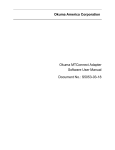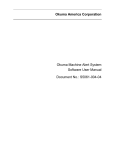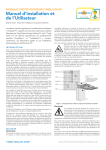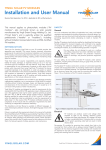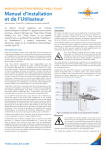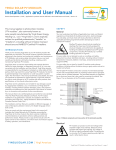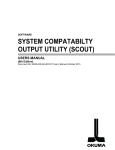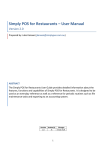Download Software User Manual
Transcript
Okuma America Corporation Okuma MTConnect Adapter Software User Manual Document No.: S5053-03-05 OKUMA MTConnect Adapter User Manual S5053-03-05 Date: 03/29/2012 Revision History Date Version Description Author 7/25/2011 S5053-03-00 Initial Release Linh Huynh 10/14/2011 S5053-03-01 Release 1.3 Linh Huynh 12/20/2011 S5053-03-02 Release 1.3.2 Update Linh Huynh 02/10/2012 S5053-03-03 Release 1.3.6 Update Linh Huynh 4.1, 5.4.4, and 7.1 02/20/2012 S5053-03-04 Release 1.3.7 Update Linh Huynh 5.4.1, and 5.4.4 02/29/2012 S5053-03-05 Release 1.3.8 Update Linh Huynh Add: 2.6 Installing MTConnect Agent (Optional) Revise: 5.4, and 7.1 Okuma America Corporation, 2012 Page 2 OKUMA MTConnect Adapter User Manual S5053-03-05 Date: 03/29/2012 Okuma MTConnect Adapter 1 Document No.: S5053-03-05 1 Revision History 2 2.6 1. 2. 3. 4. 5. 6. Installing MTConnect Agent (Optional) 2 Introduction 5 1.1 1.2 1.3 1.4 1.5 Purpose Scope Definitions, Acronyms and Abbreviations Overview Functions and Configuration 1.5.1 Function 1.6 Scope 1.7 References 5 5 5 5 5 5 5 5 Installation 6 2.1 2.2 Installation of THINC API Installation of Okuma MTConnect Adapter Software 2.2.1 Installation of Microsoft .NET Framework 4.0 2.2.2 Installation of Microsoft .NET Framework 3.5 SP1 2.2.3 Installation of Okuma MTConnect Adapter Software 2.3 Installation of THINC Startup Service 2.4 Setup Okuma MTConnect Adapter Software to Startup Automatically 2.5 Installing MTConnect Agent (Optional) 6 6 6 7 8 13 13 19 Repair/Uninstall Okuma MTConnect Adapter Software 19 3.1 19 Un-install Okuma MTConnect Adapter Software Installation Files 20 4.1 20 Okuma MTConnect Adapter Software Usage 21 5.1 5.2 5.3 Start Okuma MTConnect Adapter Application Exit Okuma MTConnect Adapter Application Main User Interface 5.3.1 Main Menu 5.3.2 File Menu 5.3.3 View Menu 5.3.4 Help Menu 5.4 Operations 5.4.1 Configurations 5.4.2 System Events 5.4.3 Components/Data Items 5.4.4 Agent & Adapter Communication 21 21 21 21 21 22 22 22 22 24 25 25 Event Log 25 6.1 25 Error Event Log Okuma America Corporation, 2012 Page 3 OKUMA MTConnect Adapter User Manual 7. S5053-03-05 Date: 03/29/2012 Trouble Shooting 26 7.1 26 26 26 27 27 27 Common Errors 7.1.1 THINC API License 7.1.2 Devices Name 7.1.3 Agent Port number 7.1.4 Adapter Port number 7.1.5 Device Configuration Okuma America Corporation, 2012 Page 4 OKUMA MTConnect Adapter User Manual S5053-03-05 Date: 03/29/2012 OKUMA MTConnect Adapter User Manual 1. Introduction 1.1 Purpose The purpose of this document is to provide the instruction of installing and operating Okuma MTConnect Adapter. It also provides information on how to repair, and uninstall this software. 1.2 Scope This manual will cover the installation, operation and trouble shooting for Okuma MTConnect Adapter running on OSP P200 controls. 1.3 Definitions, Acronyms and Abbreviations None. 1.4 Overview The Okuma MTConnect Adapter is an application that is specifically designed to support the communication interfaces between MTConnect Agent and Okuma OSP P100/P200 controls. 1.5 Functions and Configuration 1.5.1 Function • This application will start after NC is started up using Startup service. • This application allows MTConnect Agent provided by MTConnect to collect machine data. • The system performs the following tasks routinely: Send update data to connected Agents Note: All error messages will be set as top mode and cover NC screen. Operator will need to acknowledge the message by touching the application. 1.6 Scope Current version of OKUMA MTConnect Adapter only supports OKUMA P200 controls or higher. This adapter must be used with an agent developed by MTConnect.org and can be download at https://github.com/mtconnect/cppagent 1.7 References [1] Installation Manual for THINC API [2] Installation Manual for Startup Service Okuma America Corporation, 2012 Page 5 OKUMA MTConnect Adapter User Manual S5053-03-05 Date: 03/29/2012 2. Installation 2.1 Installation of THINC API This application requires THINC API version 1.12.1.0 or greater to be installed on machine. Refer to THINC API ‘InstallationManual.pdf’ provided on THINC API Installation disk for instructions. Tip: Try to run THINC API Demo Application and see if it runs normally to make sure THINC API is properly installed. It is always best to install the latest version of THINC API on the machine if possible. 2.2 Installation of Okuma MTConnect Adapter Software Run the ‘Setup.exe’ program from the Okuma MTConnect Adapter DVD to install Okuma MTConnect Adapter software. The setup program automatically checks if Microsoft .NET framework 4.0/3.5 SP1 is installed. If it is not installed, continue to section 2.2.1, otherwise refer to section 2.2.3. OSP software should not be running during the installation of Okuma MTConnect Adapter or .NET Framework 4.0. During the .NET installation, it will be necessary to reboot multiple times. OSP software launch should be cancelled and the installation media should remain connected during the reboot. 2.2.1 Installation of Microsoft .NET Framework 4.0 The next dialog will be displayed if Microsoft .NET framework 4.0 is not installed. Okuma America Corporation, 2012 Page 6 OKUMA MTConnect Adapter User Manual S5053-03-05 Date: 03/29/2012 Figure: .NET framework 4.0 license agreement dialog Click ‘Accept’ to install .NET framework 4.0. Figure: .NET framework 4.0 installation dialog If the .NET installation requires rebooting then it needs to reboot the machine to continue the installation again. 2.2.2 Installation of Microsoft .NET Framework 3.5 SP1 The next dialog will be displayed if Microsoft .NET framework 3.5 SP1 is not installed. Okuma America Corporation, 2012 Page 7 OKUMA MTConnect Adapter User Manual S5053-03-05 Date: 03/29/2012 Figure: .NET framework 3.5 SP1 license agreement dialog Click ‘Accept’ to install .NET framework 3.5 SP1. Figure: .NET framework 3.5 SP1 installation dialog If the .NET installation requires rebooting then it needs to reboot the machine to continue the installation again. 2.2.3 Installation of Okuma MTConnect Adapter Software The following dialog will be displayed once all of the required .NET frameworks are installed. Figure: Installation welcome dialog Okuma America Corporation, 2012 Page 8 OKUMA MTConnect Adapter User Manual S5053-03-05 Date: 03/29/2012 Click ‘Next’ to continue. Figure: Installing Application folder Click ‘Next’ to continue. User can also select a different folder other than the default one to install Okuma MTConnect Adapter Software. Okuma America Corporation, 2012 Page 9 OKUMA MTConnect Adapter User Manual S5053-03-05 Date: 03/29/2012 Click ‘Next’ to continue. Okuma America Corporation, 2012 Page 10 OKUMA MTConnect Adapter User Manual S5053-03-05 Date: 03/29/2012 Application is installing. Okuma America Corporation, 2012 Page 11 OKUMA MTConnect Adapter User Manual S5053-03-05 Date: 03/29/2012 This dialog provides custom setup for Okuma MTConnect Adapter. 1/ Device Information: Device Name: Name of machine as specified in Devices.xml. Note: Device or Machine name must be matched with device name specified in the agent configuration file, Agent.cfg. Device Serial Number: Unique machine number Device Description: A description of this machine 2/ OK button: The system will save current setting and update device configuration file accordingly. 3/ Cancel Button: This will cancel current installation. Click OK to move to next step Okuma America Corporation, 2012 Page 12 OKUMA MTConnect Adapter User Manual S5053-03-05 Date: 03/29/2012 Figure: Installation completed dialog Click ‘Close’ to complete the installation. 2.3 Installation of THINC Startup Service Run the ‘Setup.exe’ in the Okuma Startup Service System DVD to install THINC Startup Service. Note: User needs to restart the machine to make the startup service work properly. 2.4 Setup Okuma MTConnect Adapter Software to Startup Automatically To enable the Okuma MTConnect Adapter Software run automatically when NC OSP system is started, user needs to setup THINC Startup Service properly. Click ‘Start’ ‘Programs’ ‘Okuma’ ‘THINC Startup Service’ ‘THINC Start Settings’ to activate the startup service setup dialog as follows. Okuma America Corporation, 2012 Page 13 OKUMA MTConnect Adapter User Manual S5053-03-05 Date: 03/29/2012 Figure 1 THINC startup settings dialog Click ‘New Entry’ button at the lower left side of the dialog to add an entry for the Okuma MTConnect Adapter application. Figure: THINC startup settings add item welcome dialog Okuma America Corporation, 2012 Page 14 OKUMA MTConnect Adapter User Manual S5053-03-05 Date: 03/29/2012 Figure: THINC startup settings add item name dialog In the ‘Add Item’ welcome window, click ‘Next’ to enter the ‘Startup Type’ selection dialog, enter ‘Okuma MTConnect Adapter’ as display name and select ‘Process’ for the startup type, then click ‘Next’ button and a new dialog will pop up to allow user to browse which application to startup. Okuma America Corporation, 2012 Page 15 OKUMA MTConnect Adapter User Manual S5053-03-05 Date: 03/29/2012 Figure: THINC startup settings add item destination dialog Click the ‘Browse’ button to select file ‘OkumaMTConnectAdapter.exe’ in the Okuma MTConnect Adapter installation folder (By default, it is ‘D:\Program Files\Okuma\Okuma MT Connect Adapter\’.). Click ‘Next’ to proceed to next ‘Startup Options’ dialog. Okuma America Corporation, 2012 Page 16 OKUMA MTConnect Adapter User Manual S5053-03-05 Date: 03/29/2012 Figure: THINC startup settings add item options dialog In the ‘Startup Options’ dialog, check ‘Enabled’, ‘Launch’ and ‘Wait’, then click ‘Next’ button to go to next step Okuma America Corporation, 2012 Page 17 OKUMA MTConnect Adapter User Manual S5053-03-05 Date: 03/29/2012 Click ‘Finish’ button to finish the setup for Okuma MTConnect Adapter Software. Okuma America Corporation, 2012 Page 18 OKUMA MTConnect Adapter User Manual S5053-03-05 Date: 03/29/2012 Figure: THINC startup settings add item completed dialog Click ‘Save’ to save the settings and exit the setup process. The Okuma MTConnect Adapter Software should be launched automatically after the NC OSP system is started. Note: User needs to restart the machine to ensure that the startup service work properly. 2.5 Installing MTConnect Agent (Optional) MTConnect Agent is installed into the same location of OKUMA MTConnect Adapter. It is, however, up to user to decide to run agent on the same or different PC. Please refer to the MTConnect Agent installation file named, README.pdf, for further instruction how to configure it to connect to adapter. Note: It is important to update agent configuration setting when OKUMA MTConnect Adapter device information has been changed. 3. Repair/Uninstall Okuma MTConnect Adapter Software 3.1 Un-install Okuma MTConnect Adapter Software Start the machine in Windows only mode. Click ‘Start’ Settings ‘Control Panel’ to launch control panel. Double click ‘Add or Remove Programs’ in control panel, find the item ‘Okuma MTConnect Adapter’ and click ‘Remove’ to uninstall Okuma MTConnect Adapter Software. Note: Before performing un-installing Okuma MTConnect Adapter application, please shutdown the Okuma MTConnect Adapter application if it is running. Okuma America Corporation, 2012 Page 19 OKUMA MTConnect Adapter User Manual S5053-03-05 Date: 03/29/2012 Figure: Uninstall Okuma MTConnect Adapter software dialog Figure: Uninstall Okuma MTConnect Adapter software confirmation dialog Click ‘Yes’ to confirm uninstalling Okuma MTConnect Adapter Software. 4. Installation Files 4.1 Okuma MTConnect Adapter Software All the files are installed in the installation folder unless otherwise noted, by default, which is ‘D:\Program Files\Okuma\Okuma MT Connect Adapter’. The devices.xml configuration file will be created and configured per machine type and specification by OKUMA MTConnect Adapter. Once it is configured the device is available for communicating with an agent. Note: It is necessary to run OKUMA MTConnect Adapter application after NC is started completely to allow the application to configure the devices.xml file correctly per machine configuration and specification. Once it is configured MTConnect agent can connect to it. Okuma America Corporation, 2012 Page 20 OKUMA MTConnect Adapter User Manual S5053-03-05 Date: 03/29/2012 5. Usage 5.1 Start Okuma MTConnect Adapter Application The Okuma MTConnect Adapter Software will be launched automatically by the Start-Up service after NC is started completely. If user exits the software and wants to launch it again, press ‘Ctrl + ’ on the operation panel to pop up Start Menu, then click ‘Programs’ ‘Okuma’ ‘Okuma MTConnect Adapter’ ‘Okuma MTConnect Adapter Application’ to run. After the application is launched without error, it will be minimized in the system tray and shown as an icon user double clicks the icon or select ‘Show’ from the pop-up menu, the main user interface will be displayed. Note: The detail messages displayed in the main user interface does depend on each machine configuration. Figure: Okuma MTConnect Adapter Software main user interface 5.2 Exit Okuma MTConnect Adapter Application When user shuts down the machine, the software will be terminated automatically without user interaction. Click the exit button will also terminate the software. In normal operation, only user with administrative right can perform this operation. 5.3 Main User Interface 5.3.1 Main Menu The main menu is at the top of main user interface, including four submenus, which are ‘File’, ‘View’, and ‘Help’ submenu. 5.3.2 File Menu The ‘File’ menu has one submenu item, which is ‘Exit’. When the ‘Exit’ submenu item is selected, the application will be closed. Okuma America Corporation, 2012 Page 21 . If OKUMA MTConnect Adapter User Manual S5053-03-05 Date: 03/29/2012 5.3.3 View Menu The ‘View’ menu has four submenu items, which are ‘Clear Messages’, ‘Trace On’, ‘System Tray’, and Get Current. When the ‘Clear Messages’ submenu item is selected, all the messages displayed in the client area of the main user interface are erased. When the ‘Trace On’ submenu item is checked, a message is displayed when data item is changed if there is at least 1 client connecting to the system. When the ‘System Tray’ submenu is selected, the main user interface is hidden and the icon for this application is shown in the system tray of windows task bar. When the ‘Get Current’ menu is clicked, the system will display a message in the System Events tab. The message contains all current values of all components currently supported by the device. 5.3.4 Help Menu The ‘Help’ menu has one submenu item ‘About’. When the ‘About’ submenu item is selected, a dialog is displayed to show the information about this application. Figure: Okuma MTConnect Adapter About box 5.4 Operations The OKUMA MTConnect Adapter application’s main interface has 2 tabs which are System Configurations, and System Events. 5.4.1 Configurations This tab provides configurations for the application. Notes: Any change in the System or Device Configuration might update the Devices.xml file, accordingly. Okuma America Corporation, 2012 Page 22 OKUMA MTConnect Adapter User Manual S5053-03-05 Date: 03/29/2012 5.4.1.1 System Configuration This operation allows user to configure different configurations for the application. Upon completion of configuration, the system will try to re-initialize completely with new configuration. It requires an administrative level to perform. The system will verify the input user name and password before allowing user to save the configuration. Polling Time (msec): Polling interval is in msec. Default value is 1000 msec. It should not be less than 100 msec interval. Max. Client Connections: Number of agents can connect to this Adapter. Default value is 10 agents. TCP Server Listening Port: The port number where it is listening for incoming connection of agents. Default value is 7878. Local Agents Only: By checking, it only accepts agents running on local machine. Heartbeat Time: The numbers of seconds the adapter will send a message back to the connected agent when it received a ping from the connected server. Note: Agent must be restarted to be able to accept new heartbeat time from client. Note: All current agents must connect to the OKUMA MTConnect Adapter again after system configuration. In normal operation, only user with administrative right can perform this operation. 5.4.1.2 Device Configuration This operation allows user to set MTConnect device configuration for the application. Upon completion of device configuration, the system will try to re-initialize completely with new configuration. It requires an administrative level to perform. The system will verify the input user name and password before allowing user to save the configuration. Okuma America Corporation, 2012 Page 23 OKUMA MTConnect Adapter User Manual S5053-03-05 Date: 03/29/2012 Note: The system configuration must have been configured first before Device Configuration is allowed. It is based the current Devices.xml configuration file of current machine specification. This dialog provides custom setup for Okuma MTConnect Adapter. 1/ Device Information: Device Name: Name of machine or device name as specified in device.xml. Note: Device or Machine name must be matched with device name specified in the agent configuration file, agent.cfg and it is case sensitive. Device Serial Number: Unique machine number Device Description: A description of this machine 2/ OK button: The system will save current setting and update Devices.xml accordingly. In normal operation, only user with administrative right can perform this operation. 3/ Cancel Button: This will cancel current installation. Note: All current agents must connect to the OKUMA MTConnect Adapter again after system configuration. 5.4.2 System Events By default, the system will write event messages to the System Events tab in the descending order such that newest event message will be displayed on the top of the list. If the ‘Trace On’ menu is checked, all messages will be displayed on the main user interface, otherwise only pre-selected event messages by the system will be displayed. Event messages are categorized into different event types as following: Okuma America Corporation, 2012 Page 24 OKUMA MTConnect Adapter User Manual - S5053-03-05 Date: 03/29/2012 Information – Indicate normal event messages. It is in black color. Tracing – Indicate tracing event messages when Trace On mode is enabled from menu. It is in blue color. Warning – Indicate warning event message. It is in orange color. Error – Indicate error event messages when system encounters. Error messages will be forced to display to main GUI and logged. It is in red color. Fatal – Indicate critical error event messages when system encounters. Error messages will be forced to display to main GUI and logged. It is in violet color. By double clicking on the event message in each row, a message box will be displayed contained the message in the current selected row. When the system encounters an error and the application is currently not visible, the application will be displayed and will be on top of other applications current running in Windows including NC HMI. This allows user to perceive the error currently active in the system. If application is in Top Most mode it will be out of this mode when user clicks on the application. Note: Error happened during initializing or applying new system configuration must be resolved in System Configuration. 5.4.3 Components/Data Items The components and data items that can be supported by this adapter are described in the Devices.xml configuration file. 5.4.3.1 Data Items The system will monitor all data items listed in Devices.xml per machine configuration and sends out only the data items having value being changed to the connected agents. Any agent first connects to the system will receive all data items values. 5.4.4 Agent & Adapter Communication This adapter will send data to the connected MTConnect agents using socket in a pipe (|) delimited stream according to the descriptions given in the adapter guide by MTConnect. The agent can be run on the same PC where the adapter running or can be run on a remote PC. It is up to the end user to configure the agent configuration file and adapter communication channel for local or network connection. Each time an agent is connected or disconnected a message will be displayed in the system event. There are schemas of MTConnect included in the installation folder if needed by client applications. The OSP-P control does not natively include a compatible HTTP application for capturing the agent xml stream. 6. Event Log 6.1 Error Event Log The error information for the application is logged in the Windows event log which user can read from windows system ‘Event Viewer’. The source for this event log is ‘Okuma MT Connect Adapter’. To view the event log, press ‘Ctrl + ’ on the operation panel to pop up Start Menu, then click ‘Settings’ ‘Control Panel’ ‘Administrative Tools’ ‘Event Viewer’ to launch windows event viewer, click ‘OACMTAdapter’ under ‘Event Viewer (Local)’ to see a list of events logged for Okuma MTConnect Adapter application. To see the detail of each event, Okuma America Corporation, 2012 Page 25 OKUMA MTConnect Adapter User Manual S5053-03-05 Date: 03/29/2012 double click the event item. 7. Trouble Shooting By default, the system will write event messages to the main user interface. If the ‘Trace On’ menu is checked, all messages will be displayed on the main user interface, otherwise only pre-selected event messages by the system will be displayed. Note: When the Trace On menu is checked, all process states monitored in the system will be displayed on the event message tab when the states are changed as shown: 7.1 Common Errors 7.1.1 THINC API License Failed to start application correctly Probable faulty locations: • Older version of THINC API is installed on control Measure to take: • Install the latest version of THINC API on control 7.1.2 Devices Name MTConnect Agent could not connect to OKUMA MTConnect Adapter Probable faulty locations: Okuma America Corporation, 2012 Page 26 OKUMA MTConnect Adapter User Manual • S5053-03-05 Date: 03/29/2012 MTConnect device name is case-sensitive. Measure to take: • Check agent configuration for correct device name 7.1.3 Agent Port number MTConnect client application could not connect to agent Probable faulty locations: • By default, agent is running on port 5000 Measure to take: • • Check client application to connect with agent on port 5000 Check network configuration for allowing connection with current setting port in agent. 7.1.4 Adapter Port number MTConnect agent could not connect to OKUMA MTConnect Adapter Probable faulty locations: • By default, OKUMA MTConnect Adapter is running on port 7878 Measure to take: • • Check agent configuration file to connect with adapter on port 7878 or current port setting. Check network configuration for allowing connection with current port number 7.1.5 Device Configuration In order to configure device, the application must be able to connect to NC. The adapter will configure generated and configure the Devices.xml once it can connect to NC. Probable faulty locations: • Devices.xml file is not available yet due to NC is not running yet Measure to take: • • Start Okuma MTConnect Adapter after NC is fully started. Registered Okuma MTConnect Adapter with Startup Service to allow the adapter to start after NC is fully started so it can generated and configure Devices.xml file correctly. Okuma America Corporation, 2012 Page 27 OKUMA MTConnect Adapter User Manual S5053-03-05 Date: 03/29/2012 Okuma America Corporation, 2012 Page 28





























